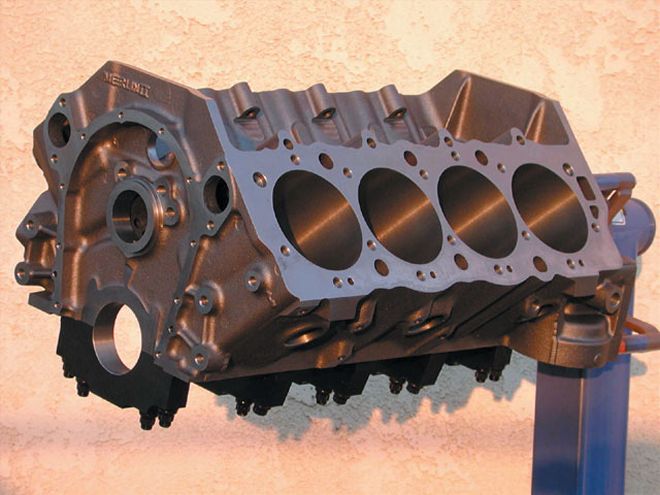

Go to build a big-block Chevy these days and you'll cough up something like $250-$500 just for a block core. Sounds cheap compared to the $1,900-$2,900 you can spend on an aftermarket block, but for some buildups, a stocker just isn't worth it in the long run. That's the decision we made for our buildup of a Procharger-blown big-block that you'll see in coming months, so HOT ROD recently took delivery of the very first Merlin III casting-a big-block Chevy replacement block from World Products that's the newest in the Merlin line. To introduce this new unit, let's take a look at the features to help you decide if the extra cash is worth it.
First, let's talk money. A junkyard 454 engine block can still be a great deal, but don't overlook the hidden costs. Based on prices and advice from Dougan's Engine, where we get most of our work done, a used block will need to be cleaned and magnafluxed ($45), bored and honed with a torque plate ($189), align-honed ($100), and surfaced with a BHJ fixture ($105). If you also want to add Milodon steel four-bolt caps, that's another $350 for machine work plus about $335 for the parts. It adds up to $1,124 plus whatever you paid for the core. It also assumes that the first core you came up with passes the crack check and isn't already bored 0.060 over. Some of those costs, such as honing and surfacing, may also apply if you use an aftermarket block, and the World block is obviously a much bigger initial investment. However the World block has thicker decks, beefier cylinder walls (it can be rebuilt more times), nicer main caps with splayed bolts, and the ability to be built up to 638 ci at little more than it would cost to make a 496ci out of your stock block. And the World block's rigidity will make more power through ring sealing. World's Bill Mitchell told us, "A real advantage is the quality of the machine work. The mains and decks are all dead nuts on the money. Remember, we assemble hundreds of these a year, and just like other engine-builders, we don't want to have to put any additional time into prepping the block. I know of no other aftermarket manufacturer that actually uses their own parts in real-world running engines."
The Merlin III has many of the real-world benefits of the Merlin Pro block that was used in Pro Stock for years, but without the race-only features you probably don't need. The Pro block can be drilled for any cylinder heads and lifter locations and is available in several deck heights. The Merlin III can still be bored 4.625 and accept a 4.750 stroke, but it only has a Chevy head and cam pattern and is not available in raised-cam versions. There won't be any surprises-all your regular Chevy stuff will bolt right up. The Merlin is good to at least 2,000 hp, while we get scared when stock blocks approach 750. And if you plan to rebuild more than once, then the Merlin offers a better value. Make the call.
Merlin III Options Part Number Deck Height Bore Caps 081100 9.8 4.{{{240}}} Nodular iron 081110 10.2 4.240 Nodular iron 081101 9.8 4.490 Nodular iron 081111 10.2 4.490 Nodular iron 085010 9.8 4.490 Billet steel 085110 10.2 4.490 Billet steelAll versions are also available fully prepped including final bore honed to finished size with torque plates, lifter bores honed, cam bearings and freeze plugs installed, washed, painted, and bagged ready for final assembly. The additional cost is about $300, which is a really good deal.
BLOCK COMPARO Merlin III Stock Four-bolt mains, center three splayed Non-splayed four-bolt or two-bolt Steel caps Cast-iron caps Fits 4.750 stroke 4.250 max stroke with grinding 4.625 max bore 4.310 max bore on most blocks 638 max ci 496 max ci 9.800 or 10.{{{200}}} deck heights 10.200 deck very hard to find 0.750-thick deck at 9.810-9.820 height 0.250-0.650 deck thickness (varies) 0.440-thick cylinder walls at 4.490 bore 0.303-thick at 4.250 bore (varies) Blind head-bolt holes Head bolts go into water jacket Priority-main oiling Lifters fed through rear cam bearing Solid oil-pan rails Oil galley in driver-side pan rail Drilled for Chevy or Moroso oil pan Chevy pan pattern only Consistent deck pattern Pattern varies from year to year Accepts Mk IV, V, or VI heads Block/heads/gaskets must match Extra head-bolt bosses in lifter valley No provision for extra head clamping Two-piece rear seal for traditional crank Depends on year of the block Clutch-ball hole in forward position only Usually has two holes for clutch balls Mechanical fuel-pump boss Depends on year of the block Approximately 275 pounds Approximately 245 pounds